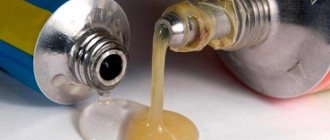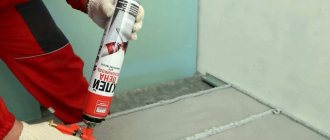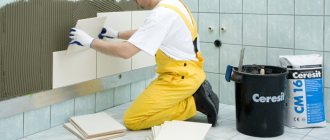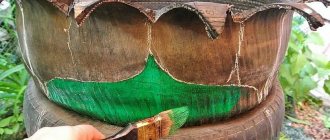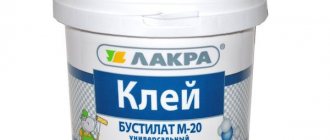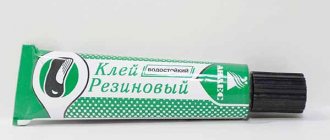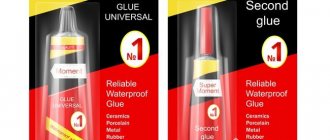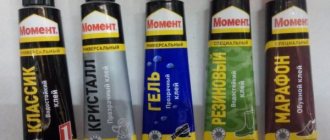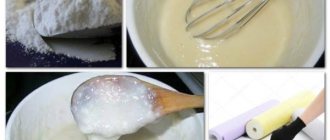Properties and types of adhesive compositions
Rubber and metal are combined with compounds based on rubber, which dissolves in special components. After hardening, the mass remains elastic, which allows it to tightly fasten materials with a heterogeneous structure. The composition can be supplemented:
- polymer resins;
- cross-linking agents;
- vulcanizing additives;
- plasticizers.
The glue is used in home and industrial settings. Fills small voids, cracks, seams. Often used as a sealant. Rubber glue is characterized by:
- high penetrating ability;
- seam strength during long-term use;
- resistance to high and low temperatures, aggressive components and chemicals;
- increased elasticity of the connection;
- neutral smell;
- transparency.
Any substance is waterproof and protects the glued area from moisture getting inside. There are heat-resistant compounds that can withstand temperatures above +100 °C.
There are two types of mixtures based on the amount of dry residue.
- Group A – flexible substance, 6-8%.
- Group B - after drying, a less flexible seam is formed, 8-12%.
Rubber compounds are classified according to the type of synthetic components.
- Rubber. Products based on natural rubber have average adhesive properties and are poorly resistant to temperature changes and the effects of natural factors. They glue simple metal elements together.
- Chloroprene. Metal oxides are added to them for reliable adhesion to the iron base.
- Butadiene-nitrile. The vulcanizing component is sulfur. Additionally there are thiurams. These are ultra-waterproof substances with good adhesion to rubber and metal parts.
- Organosilicon. The composition hardens with the participation of tetrabutoxylane. Used for gluing rubber together. Widely used in auto repair shops for tire repair.
Household adhesives are sold in small tubes or bottles. Industrial ones are packaged in cans, buckets or drums, and are applied only with special equipment.
How and how to firmly glue rubber to metal
You can firmly glue rubber to metal using brands 88, Moment, Kernil, Radical, 4508 and 4NB-UV.
Properties and types of adhesive compositions
Rubber and metal are combined with compounds based on rubber, which dissolves in special components. After hardening, the mass remains elastic, which allows it to tightly fasten materials with a heterogeneous structure. The composition can be supplemented:
- polymer resins;
- cross-linking agents;
- vulcanizing additives;
- plasticizers.
The glue is used in home and industrial settings. Fills small voids, cracks, seams. Often used as a sealant. Rubber glue is characterized by:
- high penetrating ability;
- seam strength during long-term use;
- resistance to high and low temperatures, aggressive components and chemicals;
- increased elasticity of the connection;
- neutral smell;
- transparency.
Any substance is waterproof and protects the glued area from moisture getting inside. There are heat-resistant compounds that can withstand temperatures above +100 °C.
There are two types of mixtures based on the amount of dry residue.
- Group A – flexible substance, 6-8%.
- Group B - after drying, a less flexible seam is formed, 8-12%.
Rubber compounds are classified according to the type of synthetic components.
- Rubber. Products based on natural rubber have average adhesive properties and are poorly resistant to temperature changes and the effects of natural factors. They glue simple metal elements together.
- Chloroprene. Metal oxides are added to them for reliable adhesion to the iron base.
- Butadiene-nitrile. The vulcanizing component is sulfur. Additionally there are thiurams. These are ultra-waterproof substances with good adhesion to rubber and metal parts.
- Organosilicon. The composition hardens with the participation of tetrabutoxylane. Used for gluing rubber together. Widely used in auto repair shops for tire repair.
Household adhesives are sold in small tubes or bottles. Industrial ones are packaged in cans, buckets or drums, and are applied only with special equipment.
What kind of glue should it be?
A composition with increased adhesive characteristics is capable of firmly gluing, the seam of which will be reliable and elastic. Additionally taken into account:
- operating temperature of the glued part;
- indoor humidity;
- load exerted on glued surfaces;
- what elastic properties should the part have after gluing;
- chemical aggression towards treated surfaces.
Be sure to read the instructions; the manufacturer must indicate in it that the composition is suitable for rubber and metal alloys. After drying, a high-strength, water-resistant seam should be formed that maintains its strength at low and high temperatures.
To glue parts in cars, you should buy products like “liquid rubber”; they create a single plane with the treated surface, which makes the seams visually invisible. When gluing silicone rubber, a mixture is used, the packaging of which states that it is for elastic materials.
Glue 88
Based on phenol-formaldehyde resin. Contains organic solvents, ethyl acetate, nefras. It glues materials of different textures well. Suitable for painted, concrete, glass and wood surfaces. This is a waterproof adhesive that will not delaminate due to moisture. When dry and after drying, it does not emit toxic fumes. Does not cause metal corrosion. Compounds of the SA and N series are suitable for rubber. “N” is more durable, but requires a longer exposure after gluing than 88 CA.
You must work in a well-ventilated area.
An analogue is U425-3, it has a similar composition. If necessary, vulcanization is done.
Glue 4508
Product based on rubber solution. They are used in the shoe industry, in the repair of wetsuits, rubber boats, chemical protection, and for gluing any cameras. The area is vulcanized during use of the entire item, so hot processing when gluing is not necessary. A moisture-resistant, strong seam that is resistant to vibration is created. It has increased elasticity and resistance to temperatures up to +50 °C.
4NB-UV
- An oil-resistant, water-resistant connection is created that can withstand temperatures up to no more than +60 °C.
- 4NB-UV – frost-resistant, not damaged at -40 °C.
- Rubber, iron, rubber-fabric materials are glued.
- The seam has residual stickiness and elasticity.
- Suitable for repairing water transport, wetsuits and chemical protection made of rubber.
Rubber adhesive grade A
Transparent composition based on natural rubber. It is easy to use on surfaces of any material. After drying, the base remains clean and the seam is neat, so it is used in decorative and applied arts. When performing repair or construction work, it can be used as a sealant. Forms an elastic seam that is resistant to oils, gasoline, and precipitation. Dries quickly and does not require preliminary degreasing of surfaces.
What kind of glue should it be?
A composition with increased adhesive characteristics is capable of firmly gluing, the seam of which will be reliable and elastic. Additionally taken into account:
- operating temperature of the glued part;
- indoor humidity;
- load exerted on glued surfaces;
- what elastic properties should the part have after gluing;
- chemical aggression towards treated surfaces.
Be sure to read the instructions; the manufacturer must indicate in it that the composition is suitable for rubber and metal alloys. After drying, a high-strength, water-resistant seam should be formed that maintains its strength at low and high temperatures.
To glue parts in cars, you should buy products like “liquid rubber”; they create a single plane with the treated surface, which makes the seams visually invisible. When gluing silicone rubber, a mixture is used, the packaging of which states that it is for elastic materials.
How can you glue metal to rubber?
Glue 88
Based on phenol-formaldehyde resin. Contains organic solvents, ethyl acetate, nefras. It glues materials of different textures well. Suitable for painted, concrete, glass and wood surfaces. This is a waterproof adhesive that will not delaminate due to moisture. When dry and after drying, it does not emit toxic fumes. Does not cause metal corrosion. Compounds of the SA and N series are suitable for rubber. “N” is more durable, but requires a longer exposure after gluing than 88 CA.
You must work in a well-ventilated area.
An analogue is U425-3, it has a similar composition. If necessary, vulcanization is done.
Glue 4508
Product based on rubber solution. They are used in the shoe industry, in the repair of wetsuits, rubber boats, chemical protection, and for gluing any cameras. The area is vulcanized during use of the entire item, so hot processing when gluing is not necessary. A moisture-resistant, strong seam that is resistant to vibration is created. It has increased elasticity and resistance to temperatures up to +50 °C.
4NB-UV
- An oil-resistant, water-resistant connection is created that can withstand temperatures up to no more than +60 °C.
- 4NB-UV – frost-resistant, not damaged at -40 °C.
- Rubber, iron, rubber-fabric materials are glued.
- The seam has residual stickiness and elasticity.
- Suitable for repairing water transport, wetsuits and chemical protection made of rubber.
Rubber adhesive grade A
Transparent composition based on natural rubber. It is easy to use on surfaces of any material. After drying, the base remains clean and the seam is neat, so it is used in decorative and applied arts. When performing repair or construction work, it can be used as a sealant. Forms an elastic seam that is resistant to oils, gasoline, and precipitation. Dries quickly and does not require preliminary degreasing of surfaces.
Moment Rubber
Reliably attaches hard, foam rubber. Creates a durable, water- and oil-resistant, flexible adhesive seam. Heat-resistant, withstands temperatures from -30 to +100 °C.
Radical
High-strength adhesive that is not damaged even when exposed to salt water. Bonded bases are used in salty and alkaline environments. Suitable for repairing inflatable boats. The seam can withstand high pressure, heavy loads and temperatures from -40 to +70 °C.
Kernil
It is based on innovative components.
Sold only online.
The kit includes an activator that expands the application possibilities. The operating instructions have been translated into Russian. Tightly bonds rubber in just one minute.
How to glue rubber to rubber
More and more often we come across products made of rubber that we want to repeat with our own hands. But what kind of glue should I use for this? Or another option: there is a thing that you once treasured, but now it is gathering dust on the shelf because it requires repair - a simple gluing of rubber parts. And again you need glue. Rubber products are all around us, but when they fail, we feel sad and disappointed.
This happens because this elastic, weather-resistant and waterproof material fails one day. And we find cuts and deep scratches on it.
In difficult times you can’t do without glue
And you need to choose exactly the composition that will withstand all the tests and will not let you down - the one whose properties will meet the requirements.
Requirements often have a wide range, which is why manufacturers offer a lot of materials that will restore the functionality of a damaged item. Unfortunately, there is no universal offer due to the variety of purposes of things. Therefore, before purchasing, you should carefully consider what you want to achieve from the adhesive composition, so as not to become a victim of carelessness and disappointment later.
Carefully reading the instructions will help you avoid misuse of glue. And only then should you make purchases on the construction market.
Most common requirements
They are standard: reliability and quality of connection of parts. Construction Markets will offer you a huge assortment for this. Because rubber can be glued together with glue for metal and adhesive material for plastic. We carefully read the instructions on the package, all the characteristics indicated there and decide: do we need this?
Perhaps you would like to glue rubber to metal, glue it to leather, or other materials. Just first find the composition on the packaging of which this will be guaranteed to you. Otherwise, you can easily make a wrong choice. There is no instruction on gluing the material you need - it’s better to look for another one than to become a victim of a rash decision.
Expectations and reality
I really want them to match! And your rubber boats, car tires, mattresses for sleeping or swimming, tents and wetsuits, balls and rubber shoes could serve you for a long time.
This means that the adhesive composition must meet the following requirements:
- Firmly adhere the surfaces.
- Fill all microcracks and voids.
- Be resistant to humid environments, freezing and high temperatures.
- Ensure connection strength.
- Free the seam from delamination.
- Do not dissolve when exposed to aggressive environments.
- Ensure product flexibility.
- Have a transparent structure when required.
- There should be no unpleasant, pungent odors.
Found something similar? Congratulations! In your hands is the best glue ever invented by specialists.
How to glue rubber to rubber tightly?
Let's consider options for reliable and high-quality adhesives for rubber
Rubber glue 88
The so-called 88 glue is an excellent option for gluing rubber. It contains phenol-formaldehyde resin and a rubber mixture. The resin is part of ethyl acetate with nefras, and this compound gives the very water resistance we need. And the setting time will suit our expectations.
The important characteristics of 88 glue are the following parameters common to all its versions:
- 11 kgf/cm2 – tensile strength characteristic;
- consumption in the case of gluing rubber with an area of 1 m2 - 300 grams;
- the glued seam will withstand temperatures from -40 degrees. up to +70 degrees. Celsius.
Glue 88 gives good performance when gluing parts made of foam rubber, metal, synthetics and other materials. Would you like to tightly connect leather products or parts made of glass or concrete? Feel free to use this rubber cement and you can't go wrong.
88 glue and its various derivatives are in demand among motorists, industrial and individual builders.
U425-3 and 4NB-UV
If you need subsequent rubber vulcanization, pay attention to U425-3. Its production is based on rubber, ethyl acetate and nefras.
4NB-UV is also used for rubber that requires vulcanization. This one-component adhesive guarantees a waterproof and oil-resistant connection. Withstands temperatures from -40 degrees. up to +60 degrees °C. The eyes of those involved in shoe production or repair, those who produce agricultural machinery, rubberized fabrics or materials made from rubber - synthetic or natural - are turned to him.
Rubber adhesive 4508
The glue, like all the previous ones, has a rubber based composition. What distinguishes it from others is its increased stickiness and ultra-water resistance. The seams are elastic; it is readily used in the production of textile and rubber clothing, for example, special suits made of rubberized fabrics. It is also indispensable in the production of leather goods. Suitable for repairing boats and sewing suits for fishermen.
Its composition is formed by two components, so preliminary preparation is provided. You just need to work with it away from open fire. Its cost for 200 ml is about 160 rubles.
Let's talk about glue brand A
It is also rubber cement. In everyday life it is often preferred because it is made from natural rubber. If you have to glue leather materials, cardboard products or paper, the same car or bicycle tube, and you have a tube of grade A glue on your shelf, you are saved! There is no need to prepare it first. Just open the tube, apply glue - it dries very quickly and meets all the necessary requirements for a long time. And it costs only 135 rubles per kilogram container.
Our answer to fishermen is “Radical”
They loved the glue for its elasticity and strength. And we are sure that it can handle stress or high pressure perfectly. Low temperatures are not a problem for him, just like salty sea water. Problems with kayak or boat repair? “Radical is a wonderful helper. For 50 ml you will have to pay 60 rubles.
Gummi glue
However, it will also easily seal boats and kayaks. The natural rubber in its composition will give a confident answer to the question of how to glue rubber to rubber. It also guarantees a waterproof connection. Are you engaged in the production of leather goods? We recommend choosing this glue. And the price is the same as the previous sample - the same 60 rubles for the same volume - 50 ml.
Who is not familiar with Moment glue?
Something tells me that everyone is familiar with him. And they will boldly call it one of the best when gluing rubber. Its fame is fully justified, because it is able to provide strength to any connection.
How to glue surfaces
The bases are cleaned of dust and dirt. Remove rust from a metal surface using sandpaper, a grinder or a file. This increases the adhesive ability of the surface. The rubber is not polished so as not to damage it. Before gluing, both surfaces are degreased with gasoline, alcohol or acetone.
If the composition involves hot gluing, then the parts themselves and the glue are heated to the temperature specified in the instructions. Often this is +70…+160 °C. Only after heating is the connection made.
In other cases, apply cold in accordance with the instructions.
- A thin layer of glue is applied with a brush or spatula to both parts, spaced 2 mm from the edges so that excess does not stain the front side.
- The parts are compressed until they are fully interlocked. It usually takes a little over 30 minutes. Surfaces are clamped with hands, placed under a heavy object or in a vice.
- Excess seam, which will interfere with operation, is cut off after drying and sanded with sandpaper.
- Accidentally appearing stains are removed with a knife or spatula until it is completely hardened. If the stain is dry, it is cleaned with a special compound, for example, Anti-Glue.
- The item can be used no earlier than 24 hours later.
